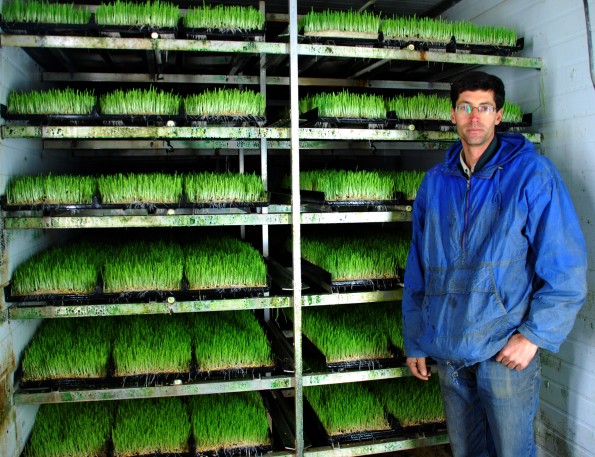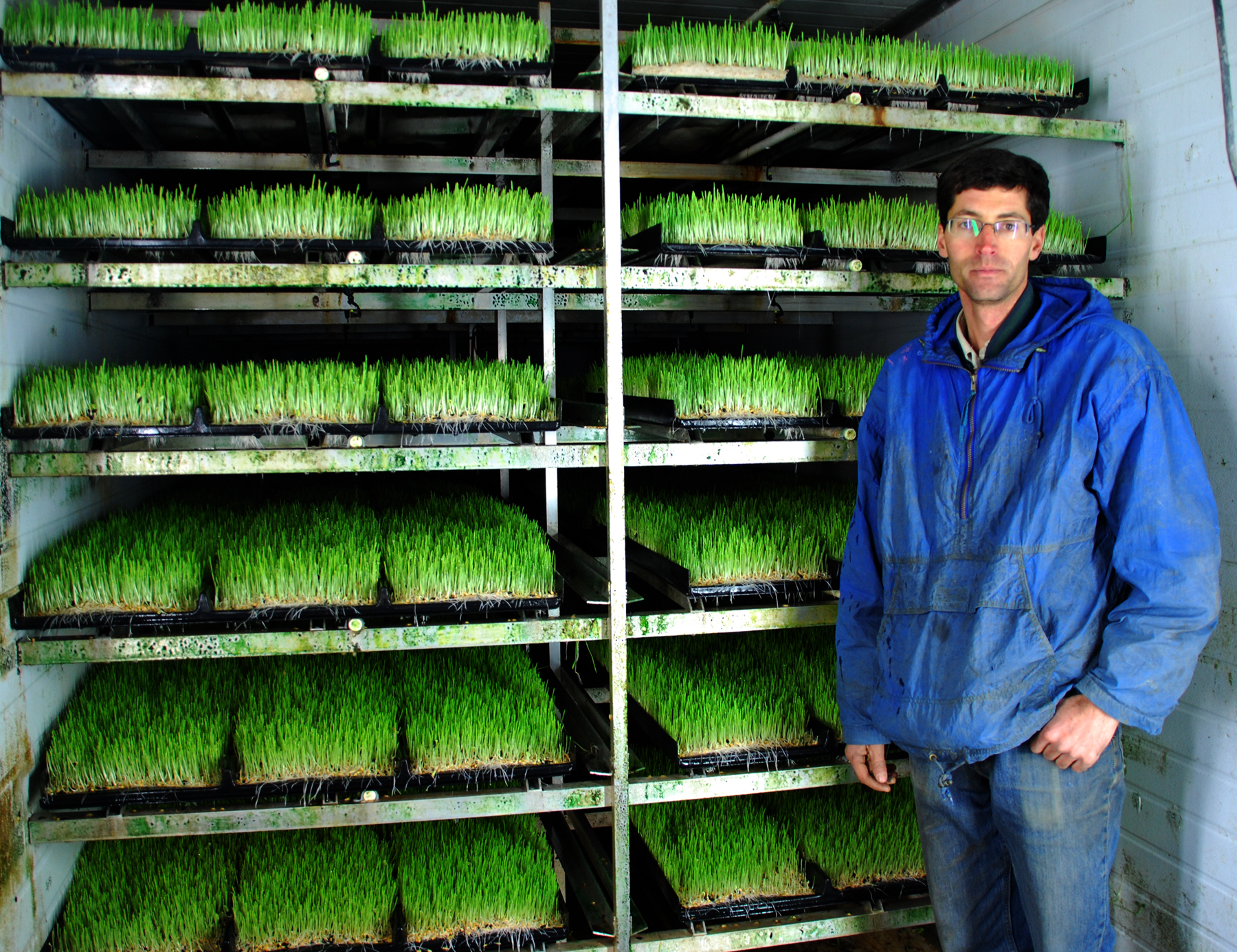Grass Farming in Salt Lake County
Utah Natural Meat offers a clear demonstration of how sustainable, local farming could work in the future. But returning to business operations my immediate question is: How does Utah Natural Meat attract a large enough customer base without signage and without marketing?
Bowler’s farm consists of several pastures for his various animals. His pigs, cows and even his chickens and turkeys all have their own pastures. He practices rotational grazing to the extent his animals rotate pastures year after year.
Due to Salt Lake County’s scarcity of both water and land, Bowler uses an ingenious system for producing healthy, organic feed for his animals. It’s especially needed in winter months most farmers purchase massive amounts of hay. He says the system has saved him thousands of dollars he would normally have to pay for hay, and uses far less space and water.
A shipping container houses a dozen or so large shelves mounted on frames. Each eight-foot column has about ten shelves of sprouting seeds in various stages of growth. Several dozen columns fit in the shipping container, which has a heating and cooling unit on top. The shelves are slid down each day through an eight-day cycle. At the back end a light comes on a timer, mimicking sunlight, which makes the sprouts grow with optimal nutrition density. “The dark green is the Omega three, which makes it much more healthy for the animals,” he explains.

On the back end, the sprouts are large and resemble a 4-inch thick piece of sod. He empties the shelves of sprouts, “I feed my pigs, cattle, goats, sheep, rabbits, even my horses and turkeys with this.” The growing trays are filled with an inch deep of barley, oats, sunflower and wheat. A mist comes from the top of the container which maintains the ideal amount of moisture. “This is some of the most nutrient-rich feed that can be grown.” And, he adds, the animals enjoy it much better than hay.”
“This sprout system is one of our answers to the lack of water. If we took the animals and we put them in pastures, it would require 90% more water. We figure it’s about 5-10 percent for cows to raise them. We can take the pasture to the cows instead of taking the cows to the pasture. That is one answer we have come up with. This also saves on fossil fuels, to allow us to produce our feed on site.”
Bowler says this system paid for itself after the second year. His underground greenhouse for growing his tomatoes is another story. Requiring no additional heating, even in winter, Shayn produces tomatoes year-round.
Shayn’s two-year-old son Grandin joins us as we visit the turkey pasture. “He stays out here and works with me until he gets too cold, then he goes in and gets warmed up and comes right out again.”
We visit his farm store, which houses about 20 massive freezers as well as a few products from other local producers including soap and honey.
I buy steaks, bratwurst, chicken and free-range grass-fed ground beef. The prices are excellent compared to the prices of major supermarkets selling grass-fed beef. Shayn tells me he only sells his meat at his farm store. He doesn’t sell at farmers markets. He has a loyal customer base and his business grows by word-of-mouth.
Once I get home and cook one of his broiler chickens. I can understand why customers keep returning. The chicken is a much different texture than corn-fed chicken. It is more dense, but the flavor is much more “chickeny.” It’s a darker, richer meat, the opposite of a rotisserie chicken we recently bought at Costco for $5. Shayn’s three-pound chicken is $15, but seeing how happy his birds live, and how enjoyable the dinner was, it’s worth the price.
Another Utah rancher I contacted through the website eatwild.com (which supports the pasture-fed movement) was Tammy of Tammy’s Grass Fed. Tammy’s operation is listed in Hooper, Utah, another growing suburb. .
Tammy told me that they were able to quickly built a reliable customer base of Salt Lake City residents who would buy an entire pasture-raised cow processed for long-term freezer storage. But eventually the family decided to sell their farm because they were feeling the pressure from nearby housing developments and suburban sprawl encroachment. It became too difficult to maintain operations among so many residential neighborhoods. They’ve since bought land in Montana, where the price per acre is much land than land with water in Utah.
“People would get freaked out when they would see a cow show up in their front yard. Cows are always going to find ways of getting out. Our neighbors would complain. And they didn’t really get that we were here first, so we decided to move. It’s been a good move for us,” Tammy says.
Tammy says she still transports a good portion of her cattle back to Salt Lake City to fulfill orders from existing customers. She is also a disciple of Joel Salatin’s teachings and she practices rotational grazing. She says that farming is the ideal lifestyle for their family. Her husband raises the beef and she sells it. Her kids are each responsible for different pastures and have their own animals. She says by doing this, “They have learned the value of hard work.”
It would be a travesty if Shayn, like Tammy, will need to move from the vicinity of Salt Lake County to maintain operations. While farmers markets are growing, Shayn says local political leaders and developers see only one good use for his farm.
“The road behind our house was once all farmland. Now the developers come in and they complain about our farm being there because it messes up their (housing) density. They want more houses and condos. Even the homeowners don’t realize what they are doing. We promote (buying) locally and then we demolish the ability to do it. I think there is a disconnect there where people don’t really understand they are a part of the problem.”






